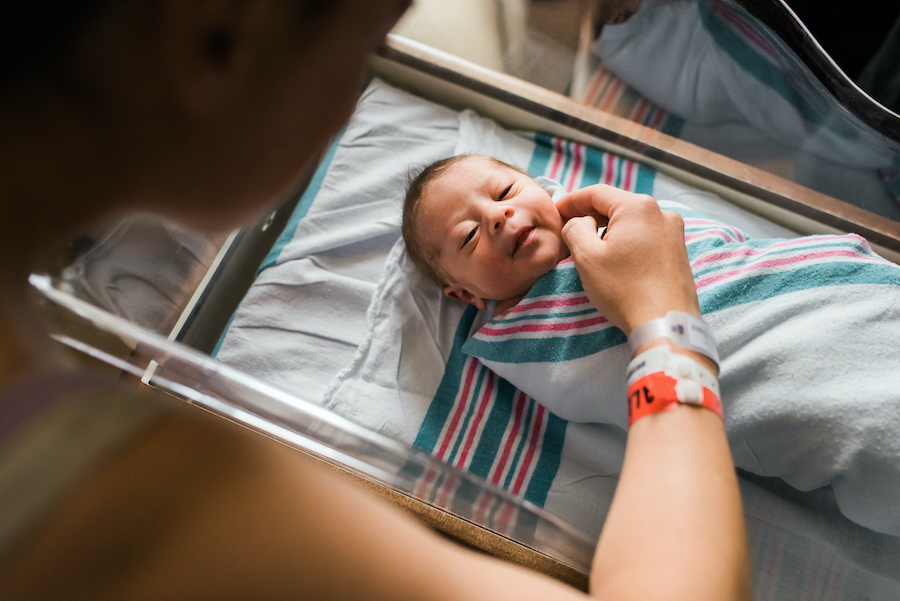
Updated February 1, 2023
Will I Ever Sleep Again?
So you have a new baby, and everyone keeps asking the same innocent question: How are they sleeping? Depending on how things are going, you may reply with a smug smile (“She already sleeps for six hours at a time!”) or you may sob, collapse to the ground, and then fall asleep then and there.
Sleep is one of the hardest things about having a baby. At first, newborns physically can’t sleep through the night. Their soft, precious tummies can only hold a few hours of milk at a time, so they need to eat every few hours. That means the best case scenario is you’re up every 2-4 hours to feed them. The more likely scenario is that you’re up at random times, spaced about 45 minutes apart, or exactly long enough to drift off to sleep but not actually rest.
It can be overwhelming, but let’s not lose more sleep, especially when there’s support! New Mexico offers free home visiting for families who have or are expecting new babies. Home visitors will come to your home (or visit via telehealth) to answer your questions. Wondering about feeding your baby? Or if they’re growing well? Or, yeah, how the heck to get them to sleep? Home visitors have the answers to these questions and more. Plus they offer another great perk: many home visiting programs will give you a free, safe sleeping cradle.
A safe sleep space is really important. Babies need to be put to sleep Alone, on their Backs, in a safe Crib (the ABCs of safe sleep). Unsafe sleep spaces can increase babies’ risk of suffocation or Sudden Infant Death Syndrome (SIDS). Safe sleep is serious, but don’t let it scare you: You have everything you need to make great choices for your baby’s safety.
To help, we spoke with safe sleep expert, Dr. Theresa Cruz. She is a professor at University of New Mexico Health Sciences Center, where she leads the Safe Sleep Project. She is also a mom of two kids who are now teenagers. One of them was a good sleeper.
“Every baby is different,” she said. “The first one, I had to wake him up. The second one was like, ‘Who needs sleep?!’”
Whether your baby is sleeping a lot or a little, Dr. Cruz said every family can keep their baby safer by following some simple guidelines.
Alone
Everyone loves baby snuggles, but bedtime isn’t the time. Babies are safest when they sleep alone, because it keeps them safe from both you and your collection of Squishmallows. In an adult bed, soft pillows or blankets can block baby’s breathing. Exhausted caregivers can also roll over on babies while bed sharing. Dr. Cruz said rollovers like this cause the majority of infant deaths in New Mexico, and she wants to bust a myth that it only happens when caregivers have been drinking and so are sleeping especially deeply.
That’s just not true, she said. “The majority of those deaths are people who weren’t drinking or doing drugs.” To avoid those risks, she said, put baby to bed in their own space.
But, they don’t have to be far away. In fact, sleep experts recommend that babies sleep in the same bedroom as the adults caring for them. Experts have found that room sharing (not bed sharing!) helps keep babies safer, probably because the adults are more likely to hear it if the baby is struggling. Does that also mean you will be woken up every time the baby whines or burps? It does. Just remember that your baby is very, very cute.
On My Back
Babies should always be put to sleep on their backs. This is Dr. Cruz’s number one tip, and is backed up by the facts. “Research has really shown that it makes a big difference to have babies sleeping on their backs,” she said, noting that infant deaths dropped by about half after back sleeping became widespread in the 1990s.
Some families may find this confusing, because pediatricians used to think it was safer for babies to sleep on their stomachs. So, you should make sure everyone who will be caring for your baby knows the up-to-date guidelines. The National Institutes of Health even has special videos aimed at grandparents and other caregivers, that you can use to spread the word.
Some families worry babies will choke if they spit up while lying on their backs, especially if they are Breaking Bad fans (beware spoilers from 2009). But actually, Dr. Cruz said, babies are less likely to choke while on their backs because the tube that goes to their lungs is actually on top of the tube to the stomach. Why does that matter? It means anything they spit up has to work against gravity to get in the way of their breathing. On their stomachs, the opposite is true.
In a Safe Crib
When you picture a crib, you may picture a traditional baby bed with bars around it. That kind of crib is great, but you can also put a baby safely to sleep in a bassinet, a dresser drawer, a box, or a traditional cradle board. The key thing is that you remove anything snuggly from your baby’s sleep space. Sure, your friends who knit (we all have them) have made adorable blankets for your baby. Plus, your mom brought out the stuffed bear from when you were a baby, and you wept about the unbroken circle of life (you’re crying a lot lately, it’s fine). Here’s what you do: Stage cute photos with these objects while your baby is awake, but never put them in the crib.
This is important, and it may look sort of lonely at first if you aren’t used to it. No blankets, no toys, just your baby on their back. It also may not look like what you see on Instagram, where sleeping babies often seem to be snuggled up with a mountain of stuffies. This is also a problem in advertisements for baby products, according to Dr. Cruz.
“Unfortunately, a lot of ads and stuff for baby things, are all these blankets and pillows and stuffed animals and all this stuff,” she said. “And really, the second most important recommendation, after putting them to sleep on their back, is having them in their own space without a bunch of stuff.” If you’re worried your baby will be cold, dress them in warm pajamas or use a sleep sack, which is a wearable blanket that keeps babies warm but can’t slip over their faces. Remember, though, that overheating is a risk factor for SIDS, so don’t overdo it.
OK, But How Do I Get This Baby to Sleep?
Now you know how to keep your baby safe while sleeping. But will they ever let you rest? Dr. Cruz said having a predictable bedtime routine is one way to help your baby learn that nighttime is for sleeping. “I’m still a really big advocate of making sure that babies have normal schedules, regular schedules that they can get used to and have their calming routine,” Dr. Cruz said. “’Oh, I know it’s bedtime because I got a warm bath, I’m in my jammies, and mom is reading to me.’”
Experts also recommend putting your baby in their crib while they are sleepy, but not yet asleep. Then, they’ll start to learn the final step of falling asleep on their own. And yes, you may have a baby who screams the moment as they are put down, no matter how sleepy they are. We have no advice for this, only solidarity. But if your baby’s sleep is becoming stressful, consider signing up for home visiting. Home visitors can provide information and support during this phase, so it doesn’t have to feel quite so hard.
As your child moves out of the newborn phase, you may try different strategies called “sleep training.” People often think this means just letting the baby “cry it out,” but there are lots of strategies, and no clear science about which method is best. “To me, as long as it doesn’t increase the risk of injury and death, I feel like parents should do whatever feels right to them,” said Dr. Cruz.
So, be gentle with yourself, and focus on safety. Even if your “sleep training approach” veers toward superstition (“He only falls asleep on nights I wear these slippers and walk backwards out of the room”) you’re probably doing a great job.

Did you find this article helpful?
Subscribe to Bright By Text to get more free tips and resources for your child’s journey, right to your phone!
